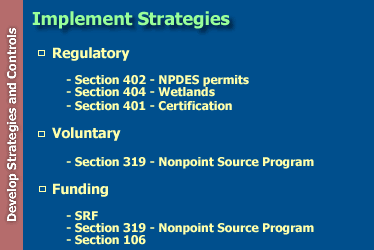

The CWA provides a number of regulatory and voluntary tools that can be useful in achieving needed reductions. (It is likely, however, that the CWA tools alone may not be sufficient to achieve needed reductions, especially in situations where nonpoint sources dominate loadings. Other tools may be available from other federal programs, state and local government programs, academic institutions, the business community, nongovernmental organizations such as land trusts, and other sources.)
Each of the CWA tools listed on the accompanying slide is covered in this module. The NPDES permit program, established in Section 402 of the Clean Water Act, regulates a wide array of discharges falling under the CWA's definition of "point" sources.
The permit program established by Section 404 of the CWA deals with the placement of dredged or fill materials into wetlands and other "waters of the United States."
Section 401 of the CWA requires that before a federal agency can issue a license or permit for construction or other activity, it must have received from the state in which the affected activity would take place a written certification that the activity will not cause or contribute to a violation of relevant state water quality standards. Downstream states whose WQS might be exceeded as a result of federal approval of the activity can also play a role in the 401 process.
CWA Section 319 created a federal program that provides money to states, tribes, and territories for the development and implementation of programs aimed at reducing pollution from "nonpoint" sources of pollution. The CWA provides no federal regulatory authority over nonpoint sources, in contrast to point sources.
By far, the largest federal source of money from the CWA comes through federal grants to states for the capitalization and operation of Clean Water State Revolving Loan programs. (In 1996, Congress created a Drinking Water State Revolving Loan Program under the Safe Drinking Water Act.)
CWA Section 106 authorizes federal grants to states, tribes, and territories to support the development and operation of state programs implementing the CWA.